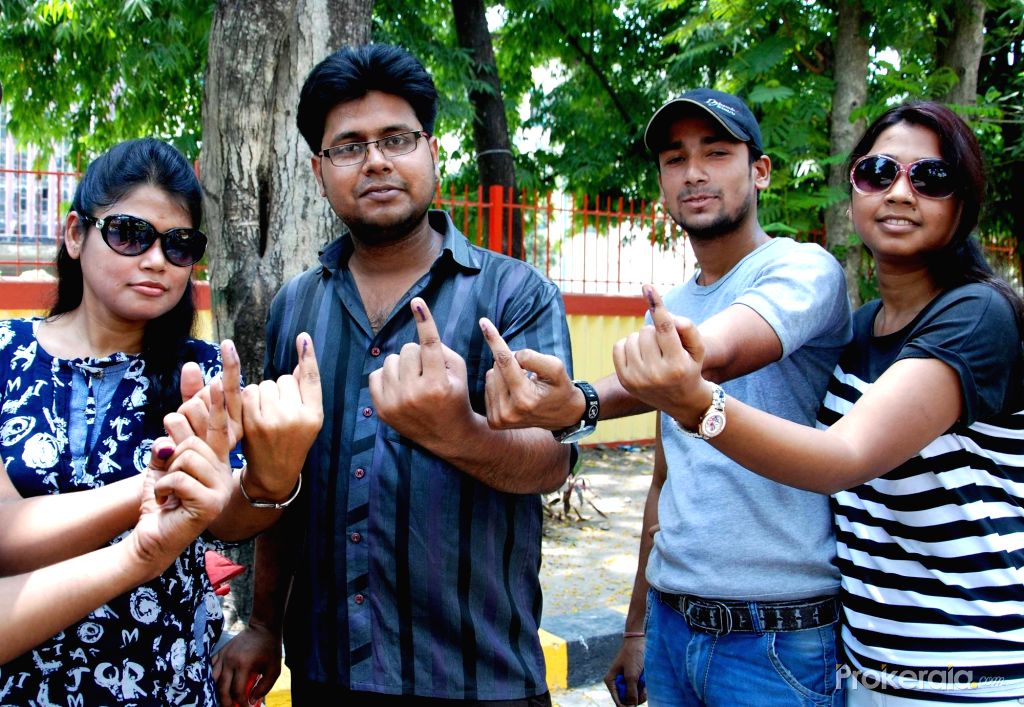In a few weeks from now there will be national election where people of the country will decide their leaders and thereby the future course of the country. Therefore, ideally, every citizen needs to set aside their ideological and emotional biases and evaluate dispassionately the issues.
It is unfortunate that even the most educated have been carried away with rhetoric and fallen prey to false information & choosing to believe the information that supports their biases. The cards are already dealt for the committed people with strong ideological leanings. However, the hope is that the large number of uncommitted and first time voters will be the key decision makers. This election is perhaps the most important, if not as important, as the elections after the emergency. Why? Because the issues at hand are significant as never before.
CONSTITUTION IS AT CROSS ROADS & VULNERABLE:
Constitution foundations have been built on a strong principle of separation of State and Religion; Freedom of expression and movement; Federal Co-operative; Democratic values etc.
The BJP has consistently reinforced the ideology propagated by its founders, Veer Savarkar, M S Golwalker, Deen Dayal Upadhyay for over three decades. The ideology propagated is that India belongs to the Hindus. This is a fundamental titanic shift for India. One has to, therefore, weigh the pros and cons of whether the future of India should be a theological state like Pakistan or strengthen the envisaged constitution for the country, not withstanding the fact that India has the second largest Muslim population in the world who opted to stay with India.
The seriousness of this issue is more because it needs 2/3rds of the majority to change the constitution. In the last elections, BJP controlled 2/3rd of the Lok Sabha and the States. The Rajya Sabha however stood as an obstacle to achieve this objective.
If this election gives the same mandate to BJP, the Rajya Sabha will also get controlled by the BJP and the constitution getting amended will become a reality. This is what makes the 2019 elections an unparalleled one.
The contrarian point of view is that India has a rich historical heritage of secular living where Hindus and other communities have lived in amity. They further claim that no country in the world has successfully survived being a theological state. They believe polarizing the society will only result in strife.
So, the issue that voters will indirectly be voting for is whether to keep the status quo of our constitution or the revocation of the existing constitution to declare India a Hindu state and all the ramifications of this approach.

The BJP ideology has shunned the constitution on the argument that it has been based on western thoughts. Indian constitution has its roots from the British and other constitutions. It believes the constitution should be based on our historical vedic culture. What this means has yet to be articulated. It is argued that this has enabled the elite of English educated minority to run the country. It is believed that there is an urgent need to revert to the rich heritage of India.
The contrarian view is that the constitution is inclusive and has served the country well for decades and is progressive in line with international scenario. If there are any important changes derived from the rich Indian past, it can always be incorporated into the existing constitution. The fact remains that while there is a desire, there do not seem to be any concrete proposals to be considered beyond rhetoric to present balanced arguments.
Voters need to, therefore, evaluate the alternate vision for the constitution and whether it will serve the future of our country better or whether to vote for the existing constitution and make it more forward looking.
JOBLESSNESS:
India’s joblessness has reached alarming proportions. According to the CMIE, the unemployment rate in India at 7.2% in Feb 2019, claimed to be the highest in the last 45 years. NSSO, a world renowned organization, has attested to similar figures in their surveys All this is contested by BJP saying that the methodology is not tested. They have withheld the release of the figures and believe that it falls short of a robust conclusion. While there are no technical flaws in the NSSO methodology, they argue that some of the analysis merit benchmarking between quarters to validate the true position. It is further argued that it does not factor in entrepreneurs created especially in the unorganized sector by Government. It is strongly argued that the jobless figures fly in the face of phenomenal (6.5-7.5%) growth & disbursal of funds under various schemes. They believe these unorganized figures are not captured.

This is contested by CMIE claiming that the monthly household surveys of large sample size does cover unorganized sector and is more authentic than derived figures from PF and other indirect sources. Therefore, they argue, the only other conclusion could be that either the GDP figures are not accurate or the impact of demonetization’s severe negative impact has not been considered. Demonetization seems to have resulted in closure of more than 30% of the unorganized sector. If this is true, how can there be higher employment creation due to this sector? Thus it is argued that BJP is underplaying the impact of demonetization.
A dispassionate look at this could argue that India’s self-employment traditionally has been forced on many due to lack of employment opportunities. The much claimed Mudra scheme has no official data available on its impact. Even the Labour ministry’s own reports show at best a marginal increase in unemployment rates. Moreover, It is now a well established fact that most researchers including World Bank have concluded that demonetization has had disastrous consequences especially on the employment in the unorganized sector. It not only reduced GDP by close to 2% but also caused nearly 30% of the unorganized and small scale industries to close down.
The unemployment issue is further complicated by the impact of technology on the existing jobs. Whichever figure one trusts, one thing that international experts agree on is that the impact of technology will render over nearly 72% of the existing jobs surplus. The skill sets and our educational curriculum will fall far short of the required skill sets in the coming decades.
The issue is how Jobs need to be created is critical for voters and has emerged as the most important concern across the country. The country needs a strategy and proactive action plan on job creation. My article on “Strategies to mitigate and resolve unemployment in India” published on February 1, 2019 provides approaches on resolving unemployment.
Voters need to therefore, demand and assess vision of different political parties and Political leaders on this critical issue. Then, benchmark it to their credibility in fulfilling their promises. Job creation can only be with the collective wisdom of a team and not by individual leaders. Therefore, voters need to vote for competent politicians with a vision on this issue.
JOB ORIENTED LED GROWTH IMPERATIVE:
There is general consensus that in order to provide jobs for the 10 million people graduating each year, the country has to grow at a minimum of 8% per annum. According to India Spend, May 2, 2018, even to maintain employment at constant annually, level, we need to create 8 million jobs annually. In 2017-18, barely 60,000 jobs were created. Assuming all these are entrepreneurial jobs created. Even assuming each entrepreneur creates an average of 6 jobs, it still falls far short of the required number. So, we need an aggressive labour oriented growth models. Moreover, inroads being made by technology require higher skills. This has the potential of marginalizing the large low skill population that characterizes the Indian labour force. All this requires a well thought out holistic approach to educational curriculum, approach to industrialization etc.
The right wing parties believe in the “trickle down” impact of industrialization especially by the large companies and MNCs. There is a very logical and strong pitch for digitization of the industry, improving productivity to be competitive, making it easy for large businesses to establish large companies that would create jobs etc. However, the world experience has shown that most of the growth has been jobless growth. Even the 2014 RBI report concluded that the previous 15-year growth of India has been jobless growth.
So, logically, the main growth needs to come from the MSMEs and agricultural front. The left wing parties advocate inclusive growth. They believe that while ecosystem must be developed for a vibrant industrial growth, it must equally emphasize on the unorganized & MSME sections. But how is that to be achieved? Our agriculture is already burdened with excessive manpower and also being non profitable, people are shying away from this sector.
Given that MSME accounts for 54% of GDP, 93% of employment and 40% of exports, its obvious our growth models need to be inclusive. The country needs to focus on agro industries, create agricultural infrastructure, encourage micro entrepreneurship by building a new ecosystem where finances for the marginal people is made possible,
So, voters need to decide on the model of growth that would best achieve the results of employment generation. For these elections, the choice is between inclusive growth or right wing growth.
PERFORMANCE OF THE ECONOMY:
How has the economy performed? BJP claims better performance than the earlier UPA era by achieving highest growth rates of 6.5%-7.3% during the last five years. NSSO back series (same basis as the changed parameters) shows that the growth rates achieved by UPA touched 10.3% on 2 years and averaged 8.5%. This has not been officially released by BJP but has not provided reasons for the same.
BJP claims that they were able to control fiscal deficit at around 3-3.5% from the high of around 7%. Opposition contests this by citing that the petroleum prices that had been hovering around $130 per barrel earlier had slumped to less than $35-40 per barrel and hence it has been possible to keep the fiscal deficits low. Opposition claims that despite high international prices, the retail petrol prices for Indian citizens were in the Rs 40 per liter range. On the other hand, while the international prices were at their lowest, retail petrol prices shot up to Rs.80 range per litter. The opposition argues that Fiscal deficit has been kept low by heavily taxing the citizens on fuel. Further, demonetization has put intense pressure on the purchase capacities of individuals.
The ruling party has been repeatedly claiming that its last five year performance exceeded the last 70 years performance of UPA. They site how India has moved up the rank on ease of doing business in the international rankings. The reality is that India is amongst the last remaining markets in the world and it is natural for international businesses to seriously look at India.
Having said this, it cannot be denied that the Prime Minister has been able to create a larger than life image that has helped in the highest Foreign Direct Investments so far in the last five years. By the same measure, BJP’s claims of electrifying all the villages in five years which was not done for 70 years is highly misleading. It has electrified barely 18,000 villages out of the total 560,000 villages. There are a number of anecdotal news that claim that even these electrifications have been superficial.
There is a stark contrast between claim and reality. The fact remains that investments have been dropping, NPAs increasing, industrial outputs have been declining, GST revenues have registered a shortfall of nearly Rs. 1,00,000 crores in its collections, 30% of the unorganized sector have disappeared. All this begs the question that if BJP claims are correct and the world economy had experienced growth, why is the Indian performance so low?
The challenge for voters is to sieve thru empirical evidence and verify each claim to arrive at a logical assessment of the challenging economic issues facing the country. Emotional rhetoric of political parties and claims should not carry voters away.
CONCLUSION:
2019 elections are crucial at an ideological & emotive issue at various levels:
- False narratives and marketing hype seems to have overshadowed the information sharing space. So, each voter has to carefully analyze for reality.
- Social Media has made narratives viral without checks and balance.
- The issues are not about programs or substance as much as about ideological models of development that will shape the country.
Each vote will have a meaningful impact. The voter has to carefully read between the lines to differentiate between claims and personal character assassinations, remarks & objurgating and empirical based facts. The need to cast their votes more on what matters to them. For example, the voter has to decide on whether job creation or economic issues are more critical for them or issues of hereditary, religious issues like Ram Mandir etc.
In this era of fake news and the propensity of the political class to play the blame game, it has only polarized even the educated professionals. In such an environment, it is impossible for forward-looking healthy consensus on the way forward.
PN: This Article is part of a series of Articles on governance and social impact, written by Mr K Vijay Rao
Disclaimer: The information, ideas or opinions appearing in this article are those of the author and do not necessarily reflect the views of N4M Media.



















